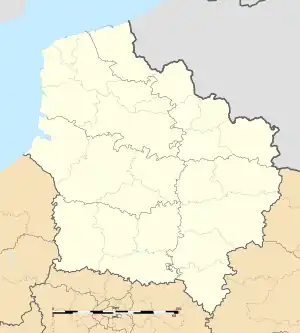Enquin-les-Mines
Enken | |
|---|---|
 Coat of arms | |
Location of Enquin-les-Mines | |
 Enquin-les-Mines  Enquin-les-Mines | |
| Coordinates: 50°35′18″N 2°17′11″E / 50.5883°N 2.2864°E | |
| Country | France |
| Region | Hauts-de-France |
| Department | Pas-de-Calais |
| Arrondissement | Saint-Omer |
| Canton | Fruges |
| Commune | Enquin-lez-Guinegatte |
| Area 1 | 11.1 km2 (4.3 sq mi) |
| Population (2019)[1] | 1,179 |
| • Density | 110/km2 (280/sq mi) |
| Time zone | UTC+01:00 (CET) |
| • Summer (DST) | UTC+02:00 (CEST) |
| Postal code | 62145 |
| Elevation | 49–118 m (161–387 ft) (avg. 84 m or 276 ft) |
| 1 French Land Register data, which excludes lakes, ponds, glaciers > 1 km2 (0.386 sq mi or 247 acres) and river estuaries. | |
Enquin-les-Mines (French pronunciation: [ɑ̃kɛ̃ le min]; West Flemish: Enken; Picard: Inquin-les-Mines) is a town and former commune in the Pas-de-Calais department in the Hauts-de-France region of France.[2] Since January 2017, it is a delegated commune of Enquin-lez-Guinegatte.[3]
The inhabitants of the town of Enquin-les-Mines are known as Enquinois, Enquinoises in French.[4]
The commune was surrounded by the municipalities of Erny-Saint-Julien, Estrée-Blanche and Enguinegatte. The commune merged with the latter of these on 1 January 2017 to form the commune nouvelle of Enquin-lez-Guinegatte.[5]
Geography
Enquin-les-Mines is a farming village situated 12 miles (19 km) southwest of Saint-Omer, at the D77 and D158 crossroads, by the banks of the small river Laquette.[6]
Population
| Year | 1962 | 1968 | 1975 | 1982 | 1990 | 1999 |
|---|---|---|---|---|---|---|
| Population | 862 | 944 | 856 | 825 | 869 | 917 |
| From the year 1962 on: No double counting—residents of multiple communes (e.g. students and military personnel) are counted only once. | ||||||
History
The village was subject to much damage during the siege of Thérouanne in 1553.
The neighbouring hamlets of Fléchinelle and Serny were joined with the commune in 1822.
Places of interest
See also
References
- ↑ Téléchargement du fichier d'ensemble des populations légales en 2019, INSEE
- ↑ Des villages de Cassini aux communes d'aujourd'hui: Commune data sheet Enquin-les-Mines, EHESS (in French).
- ↑ Commune d'Enquin-les-Mines (62295), commune déléguée, INSEE
- ↑ Pas-de-Calais, habitants.fr
- ↑ Arrêté préfectoral 30 June 2016 (in French)
- ↑ "Annuaire-Mairie"